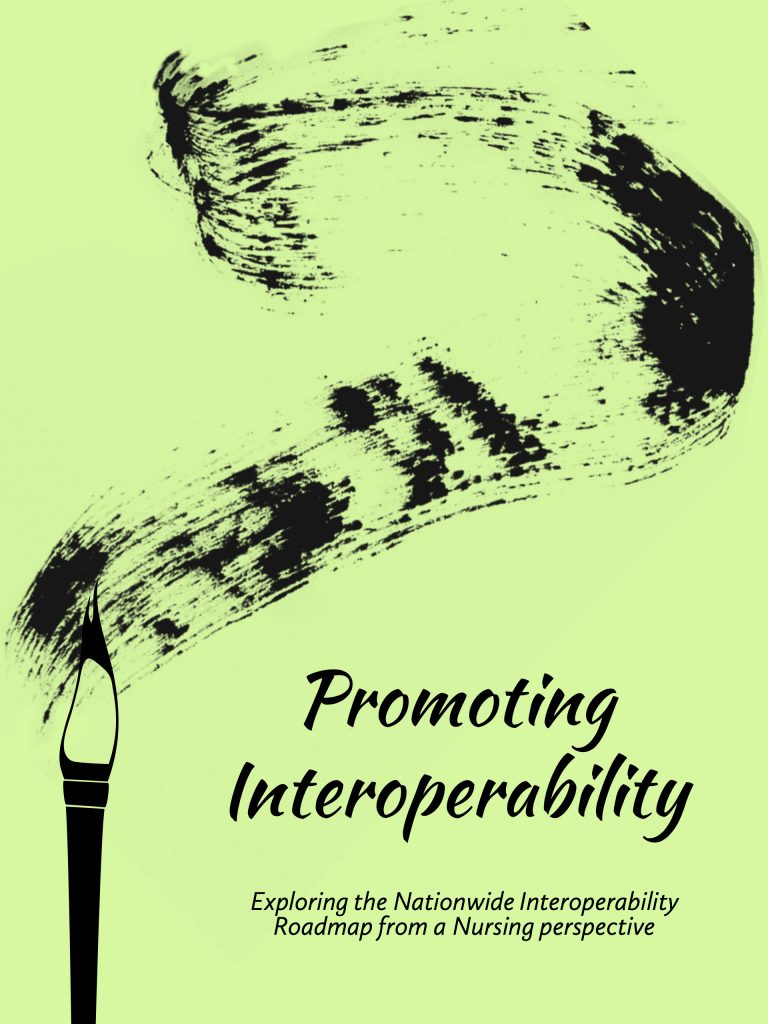By June Kaminski, RN MSN PhD(c), OJNI Editor in Chief
CITATION: Kaminski, J. (July 2018). Exploring the Nationwide Interoperability Roadmap from a Nursing perspective. Online Journal of Nursing Informatics (OJNI), 22(2). Available at http://www.himss.org/ojni
 In 2015, the Office of the National Coordinator for Health Information Technology (ONC) released a critical guiding document that continues to affect all health professionals in the U.S. This document, entitled Connecting Health and Care for the Nation: A shared Nationwide Interoperability Roadmap (final version 1.0) provided a cutting-edge plan to improve health technology services that truly serve U.S. citizens and health professionals. A key component of this plan – the heart of it, in fact, is the elusive yet mandatory focus on interoperability.
In 2015, the Office of the National Coordinator for Health Information Technology (ONC) released a critical guiding document that continues to affect all health professionals in the U.S. This document, entitled Connecting Health and Care for the Nation: A shared Nationwide Interoperability Roadmap (final version 1.0) provided a cutting-edge plan to improve health technology services that truly serve U.S. citizens and health professionals. A key component of this plan – the heart of it, in fact, is the elusive yet mandatory focus on interoperability.
For decades, nursing and health informatics experts have predicted that a primary goal of health technology is to achieve seamless interoperability across all spectrums of the health care system from acute care to community based prevention and health promotion initiatives. ONC (2015) adopted the Institute of Electrical and Electronics Engineers (IEEE) definition for interoperability, describing it as “the ability of a system to exchange electronic health information with and use electronic health information from other systems without special effort on the part of the user” (p. x). In 2016, IEEE expanded their definition to the “ability of a system or a product to work with other systems or products without special effort on the part of the customer. Interoperability is made possible by the implementation of standards.”
The ONC Roadmap offered realistic and time-specific goals that provided concrete directives for health decision-makers and frontline professionals. These goals included:
- 2015-2017: Send, receive, find and use priority data domains to improve health care quality and outcomes.
- 2018-2020: Expand data sources and users in the interoperable health IT ecosystem to improve health and lower costs.
- 2021-2024: Achieve nationwide interoperability to enable a learning health system, with the person at the center of a system that can continuously improve care, public health, and science through real-time data access. (ONC, 2015, p. vii).
Although nursing informatics specialists need to focus on the entire Roadmap document, perhaps the most important aspect of the guidebook for all patients and practicing nurses is the 2021-2024 goal, further elaborated as: “Individuals are able to seamlessly integrate and compile longitudinal electronic health information across online tools, mobile platforms and devices to participate in shared decision-making with their care, support and service teams” (ONC, 2015, p. 45). Once this goal is achieved, the true promise of health technology will be at our fingertips. This simple statement relates to all aspects of informatics, including electronic health records (EHR), telehealth, mobile health (mHealth), health portals, wearable technologies, community care initiatives, cognitive computing, and so forth.
In April 2018, a major Centers for Medicare and Medicaid Services (CMS) announcement was released outlining how their EHR Incentive Programs (Meaningful Use Programs) were being renamed the Promoting Interoperability (PI) Programs. CMS Administrator, Seema Verma explained: “To better reflect this new focus, we are re-naming the Meaningful Use program “Promoting Interoperability.” In addition, the proposed rule reiterates the requirement for providers to use the 2015 Edition of certified electronic health record technology in 2019 as part of demonstrating meaningful use to qualify for incentive payments and avoid reductions to Medicare payments. This updated technology includes the use of application programming interfaces (APIs), which have the potential to improve the flow of information between providers and patients. Patients could collect their health information from multiple providers and potentially incorporate all of their health information into a single portal, application, program, or other software. This can support a patient’s ability to share their information with another member of their care team or with a new doctor, which can reduce duplication and provide continuity of care” (CMS, 2018b, p.1).
Meaningful Use Stage 2 and other initiatives such as the Blue Button program were intended to guide health technology towards the goal of seamless access and interoperability. Although the language has changed, the focus has not. Interoperability has always been the heart of the Meaningful Use initiative, but now it is front row and center, which is good news for both patients and nurses. As described by Seema Verna, we need to go beyond adoption of health technology and EHRs since “EHR adoption has also created electronic siloes. We had filing cabinets before – now we have these electronic siloes. Data doesn’t mean anything unless it’s put into a format that is meaningful to the end user, whether that’s a provider or a patient. That is where we will be continuing to focus our efforts going forward” (Bresnick, 2018, p. 1).
Earlier this year, Seema Verna also announced a new MyHealthEData program augmented by Blue Button 2.0 while attending HIMSS18. “MyHealthEData is a government-wide initiative spearheaded by the White House Office of American Innovation, with participation from HHS, CMS, ONC, VA, and the National Institute of Health (NIH)” (Monica, 2018, p. 1). As outlined in the CMS press release, “CMS is committed to putting patients first, and that’s why we approach issues with healthcare data from the patient perspective. We must move to a system in which patients have control of their healthcare information in order to empower patients to make informed decisions about their health and care. By ensuring patients have access to their full healthcare records and can take it with them from doctor to doctor, provider to provider, we will increase competition and reduce costs” (CMS, 2018a, p. 1). Since it is a nursing mandate to support patient-focused care, this is good news. A national focus on true patient empowerment and control over their own health data fits this mandate beautifully.
Through the development of APIs, cognitive computing, predictive analytics, and artificial intelligence systems for healthcare, this seamless access and personal information control can truly bring health and nursing informatics into the 21st century. This is actually a goal that we have waited for, for a very long time! A preliminary step towards this outcome is the availability of Blue Button 2.0. “The Centers for Medicare and Medicaid Services (CMS) Blue Button API enables Medicare beneficiaries to connect their Medicare claims data to the applications, services, and research programs they trust.” (CMS Blue Button 2.0, 2018). Basically, this API stores data from 53 million Medicare recipients (for the past four years) including medications, treatments received, type of coverage and total cost. Organizations and institutions can integrate this API into their systems to begin to create a seamless branch of the projected national system. This is just one small step, but it is a significant one. As organizations adopt cognitive computing and artificial intelligence into their health technology systems, the goal of a vibrant learning health system can move into reality. However, technology is not the only factor: dedicated health care professionals and administration are the key to success. The ‘smart’ systems can facilitate our work, but it is the humans, the actual care providers, including nurses, who can transpose this national Roadmap into a vital part of routine health care.
“In a learning health system, data will be created and collected automatically during the routine provision of care including telehealth or e-visits, alleviating the need for duplicate entry of data into registries and other parallel systems. This data will not only seamlessly enable improvement in the quality of care, but also, as enabled by individual permission, support secondary uses of data that help to achieve important advances in population health management, public health and the generation of new biomedical knowledge. Close integration of CDS into health IT systems will enable the rapid dissemination of new knowledge to support the use of best evidence in the care of all patients, especially those with multiple, complex or rare conditions. This supports providers in ensuring they have the most updated, medically-relevant information to identify the best course(s) of treatment for the individual and discuss those options with the patient.
Further, the learning health system will require nationwide interoperability to support transparent, integrated cost and quality data, accurate outcome measures, and a continuous cycle of improvement. Information gathered and decisions made during the normal course of care will be transformed, in real-time, into computable data and knowledge that is shared across the learning health system” (ONC, 2015, p. 47).
These are exciting times in the realm of health technology – if these Roadmap goals are realized, they can support patients, nurses and all other health professionals in phenomenal ways. It is important that nursing informatics specialists and other health technology experts continue to develop their understanding and competence in promoting interoperability to achieve the ONC Roadmap goals. It will require a lot of hard work, planning, expense, and dedication, but the results are well worth it!
References
Bresnick, J. (2018). Verma: CMS Will “Use Every Lever” for Promoting Interoperability, Data Access. HealthITAnalytics. April 25. Retrieved from https://healthitanalytics.com/news/verma-cms-will-use-every-lever-for-promoting-interoperability-data-access
Centers for Medicare and Medicaid Services (CMS). (2018b). Trump Administration Announces MyHealthEData Initiative at HIMSS18. Retrieved from https://www.cms.gov/Newsroom/MediaReleaseDatabase/Fact-sheets/2018-Fact-sheets-items/2018-03-06.html
Centers for Medicare and Medicaid Services (CMS). (2018b). CMS Proposes Changes to Empower Patients and Reduce Administrative Burden. Retrieved from https://www.cms.gov/Newsroom/MediaReleaseDatabase/Press-releases/2018-Press-releases-items/2018-04-24.html
CMS Blue Button 2.0. (2018). Blue Button API Docs. Retrieved from https://bluebutton.cms.gov/developers/
HIMSS. (2018). HIMSS Statement on MyHealthEData Initiative. Retrieved from https://www.himss.org/news/himss-statement-myhealthedata-initiative
Institute of Electrical and Electronics Engineers (IEEE) (2016). Interoperability definition. Standards University. Retrieved from https://www.standardsuniversity.org/article/standards-glossary/#I
Monica, K. (2018). MyHealthEData Initiative to Improve EHR Patient Data Access. EHR Intelligence, March 6. Retrieved from https://ehrintelligence.com/news/myhealthedata-initiative-to-improve-ehr-patient-data-access
Office of the National Coordinator for Health Information Technology (ONC). (2015). Connecting Health and Care for the Nation: A shared Nationwide Interoperability Roadmap. Washington, DC: U.S. Department of Health and Human Services (HHS). Retrieved from https://www.healthit.gov/sites/default/files/hie-interoperability/nationwide-interoperability-roadmap-final-version-1.0.pdf





